|

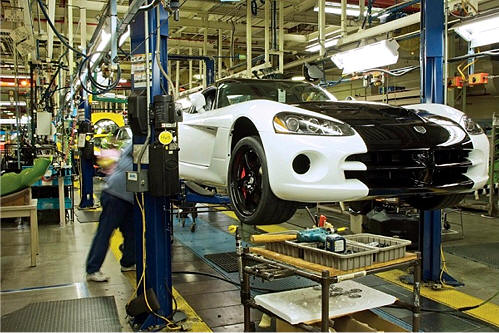
Building Gen 4's

600 HP - 0-60 mph in less than 4 seconds!
For 2008, the Viper received a 90 hp (67 kW) bump
up to 600-HP (450 kW), a 25 ft·lbf (34 N·m) torque bump up to 560 ft·lbf (759 N·m)
and the engine displacement increased up to 8.4 liters (510 ci/8354 cc) from
8.3, also receiving better flowing heads with larger valves, variable valve
timing on the exhaust cam, and dual throttle bodies. The development of the
engine was done with help from McLaren Automotive and Ricardo Consulting
Engineers.
2008 Dodge Viper SRT-10 Convertible Retail Price: $83,145.00
2008 Dodge Viper SRT-10 Coupe Retail Price: $ 83,895.00
Changes outside of the power plant are minimal, but still influential. The T56
transmission has been replaced with the new Tremec TR6060, and a revised shifter
has been paired with the new gearbox. Shifts are claimed to be 18% quicker than
Chevrolet's Corvette Z06. The Dana M44-4 rear axle from the 2003 model now has a
GKNVisco differential that greatly help the tires in getting grip under
acceleration. One last performance upgrade was the removal of run-flat tires;
the new tires remove most of the minor flaws of the early Gen III models and
should give the Viper nearly unmatched handling on any circuit. Another notable
change is the reworking of the exhaust system, previous third generation Vipers
had their exhaust crossover under the seats which resulted in a large amount of
heat going into the cockpit, this was done initially to help improve the cars
exhaust note, since the first 2 generations of Viper, which had no crossover,
were criticized for their lackluster exhaust notes. For 2008, the Viper exhaust
will utilize a new exhaust system with no crossover, reducing the heat that
enters the cockpit, but still produces an exotic sound.
Car and Driver recently tested the car and got a 0-60 mph time of 3.7 seconds, a
0-100 mph time of 7.6 seconds and a Quarter Mile-time of 11.6 seconds at 126 mph
(203 km/h). Dodge's claims for top speed are 197 mph (317 km/h) and 202 mph
(325 km/h), for the Roadster and Coupe respectively. Car and Driver also tested
the Viper's track performance, and managed a fast sub 3 minute lap time around
Virginia International Raceway. The Viper's time, despite hot weather, was
faster than the Corvette Z06, Ford GT, Porsche 911 Turbo and 911 GT3, Audi R8,
and other such cars. According to Car and Driver and Motortrend, the car's
slightly adjusted suspension setup and new diff gave it cornering ability as
sharp as before with even better control, feedback, and response.


In October 24, 2007, Dodge issued the following:
In a time when most manufacturing plants
utilize hundreds of state-of-the-art robots to assemble vehicles, a unique
plant in Detroit is producing hand-built performance vehicles.
At the Conner Avenue Assembly Plant, workers
hand-build the new Dodge Viper SRT10 and all-new 600-horsepower 8.4-liter
SRT V-10 engine. Utilizing 26 work stations on a 705-foot-long assembly
line, 48 hand-picked UAW workers assemble each vehicle. Each vehicle remains
stationary for up to 49 minutes per work area as the craft people make any
necessary adjustments. This process eliminates traditional repair stations
with all procedures verified by team members.
Each Dodge Viper is primarily made of seven
component modules (instrument panel, fuel tank, suspension corner modules,
wheels and tires, cooling module, lift gate assembly and full dressed
engine). With the exception of the engine, all modules are shipped to the
Conner facility from other locations. Stamping, casting and welding all take
place off-site with body panels arriving already painted.
In a process normally performed only on race
cars, an alignment machine sets caster and camber at normal ride height, at
jounce and at rebound (upward and downward travel of suspension). Typical
factory alignments set caster and camber in the normal ride height position
only. The 2008 Dodge Viper SRT10 is the only U.S. production vehicle set up
for such alignment at the factory.
“Our assembly process is just as exceptional
as the car,” said Melissa Holobach, Plant Manager – Conner Avenue Assembly
Plant, Sterling Heights Vehicle Test Center (SHVTC) and Pilot Operations.
“The process of building these vehicles by hand has allowed us the freedom
to produce race-inspired performance without the constraints of mass
production,” Holobach said. “Our workforce is committed to producing the
best vehicles possible and it shows in their commitment to detail.”
The all-new 600-horsepower 8.4-liter SRT V-10
engine is built next to the vehicle on a 24-station circular line by nine
Craftspersons. These nine workers assemble and certify each engine before
they are installed in the chassis.
Each Dodge Viper is tested in place on the
assembly line utilizing special rollers. At this stage the vehicle is a
rolling chassis without its body panels. During this “roll test” it is
driven through all six speeds of the transmission, up to 90 mph to verify
vehicle function.
Since its introduction as a concept car at
the 1989 North American International Auto Show in Detroit, the Dodge Viper
has captured the hearts and imagination of enthusiasts around the world. The
2008 Dodge Viper SRT10 is offered in both Roadster and Coupe versions. With
its dramatic styling and 600 horsepower, the 2008 Dodge Viper SRT10 is the
ultimate American sports car.
With 600 horsepower – 90 more than before,
and 0-to-60 performance in less than four seconds, the 2008 Dodge Viper
SRT10 sets a new benchmark for the ultimate American sports car.
The new 2008 Dodge Viper SRT10 will arrive in
Dodge showrooms in North America this fall with a new level of customization
options, including five new exterior colors, four new interior color
combinations and a new wheel design.
Old material from 2003
In 2003, a plant worker told us that Viper
staffing has been reduced, and there has been sizable turnover in the upper
reaches of plant management. More troubling are changes in plant management
and what appears to be condescending treatment of the skilled craftsmen who
build Vipers (and who used to build Prowlers).
A factory worker sent us copies of several
plant announcements which fundamentally change the way Vipers have been
built since their introduction over ten years ago. Originally, they were
made by craftsmen who controlled the line, which did not move until each
person had done their job. This ranged between an hour at most, 37 minutes
at present - the shortest time so far. Now, the line moves automatically,
unless a stop button is pressed - and people have been advised not to press
the button. This might sound reasonable, but the Viper is not a full
production car; the parts are at a prototype level of fit, with holes
sometimes containing flash, brackets sometimes not bent correctly, and
formed parts sometimes needing to be tweaked.
Management has benchmarked the Corvette and
other vehicles and is trying to build a car with prototype level parts but
production-car times; despite the fact that the Corvette is built as a
production car, with much higher volumes. With the Viper no longer being
emphasized as an image builder (perhaps because it hasn't any Mercedes
parts), workers seem to believe that, if the Viper does not earn a
substantial profit, it will be pulled.
The memos are interesting at least as much for their tone as for their
content. Note that in the 9/16 memo, the new manager - who didn't officially
start until 9/18 - complains about employees eating, sleeping, etc. during
work hours. An employee called this "ridiculous and insulting." The Viper
plant has only about one hundred people - once considered the best Chrysler
craftpeople. This behavior would be hard to get away with, and unlikely to
begin with. Ms Williams came from Toyota, which is normally seen as having
more respect forits workers.
Operations have reportedly shut down due to
lack of parts on many occasions, though breakeven is at 12 cars per day and
average is about 11 per day. Management's stated goal is to produce 13 per
day.
For 2008, the Dodge Viper SRT will use an
8.4-liter aluminum V-10 engine that produces a full 600 horsepower and 560
lb.-ft. of torque. 0-60 times are under four seconds, 0-100-0 in under 12
seconds, and braking 60-0 comes in less than 100 feet.
oh20 reported that the 2008 Viper Coupe and
Convertible both averaged over 200 mph around the Transportation Research
Center’s 7.5 mile oval test track in Ohio. The convertible even averaged 197
mph with the top down. Both have similar drag (aerodynamic) numbers,
according to representatives of the SRT team.
SRT powertrain engineers had to not only increase performance, but also
comply with regulatory requirements such as federal Tier 2, Bin 5 and
California’s Low Emissions Vehicle (LEV) 2 mandates. Working with
specialists from McLaren Performance Technologies and Ricardo, Inc., SRT
engineers began by following the racer’s basic formula for more power:
bigger displacement, more efficient breathing and higher engine speed.
The new Dodge Viper SRT10’s deep-skirted V-10
aluminum engine block was bored out 1 mm, raising the displacement to 8.4
liters from 8.3 liters. With strengthened bulkheads and improved water
jackets for better cooling, the block includes pressed-in iron cylinder
liners and cross-bolted main bearing caps for strength and durability.
Horsepower didn't come only from the engine,
the use of a plastic hood allowed engineers to increase the airflow through
the hood scoop; openings along each side are not just for show, but to
circulate air within the engine compartment, to keep power going with a warm
engine. It also lowered weight and helped keep the Viper costs down. Other
body panels are also plastic, and carbon fiber is used for some structural
parts to keep weight down.
The Viper SRT10’s 8.4-liter engine breathes
through new cylinder heads equipped with Computer Numerically Controlled
(CNC)-shaped combustion chambers, larger valves and Variable Valve Timing (VVT).
VVT electronically adjusts when the exhaust valves are open and closed
according to engine speed and load, allowing the engine to “breathe” cleaner
and more efficiently.
The 2008 Dodge Viper SRT10 V-10’s two-piece
intake manifold combines a cast aluminum lower with smooth runners for
better air flow, bolted to a die-cast aluminum upper plenum. A revised
air-cleaner box with a low-restriction filter sends air through a dual
electronic throttle control into the intake module.
The air-fuel mixture is ignited by
platinum-tip spark plugs fired by individual plug coils mounted on the
cylinder-head covers. The pistons themselves are equipped with
larger-diameter floating pins with bronze bushings for higher loads. Forged
powder-metal connecting rods are secured with aircraft-quality fasteners for
increased fatigue strength.
Engine lubrication is managed by a larger oil
pump and a swinging oil pickup adapted from Viper competition engines, to
improve oil pressure in high-rpm and hard-cornering conditions.
Spent gases exit through tubular air-gap
headers, which improve exhaust flow and ensure quick catalyst light-off. The
headers’ stamped stainless-steel outer shell acts as a thermal heat shield
for the individual stainless-steel runners that contribute to better flow
separation and exhaust tuning.
The 2008 Dodge Viper SRT10’s V-10 channels
its power through a new, smaller-diameter, twin-disc clutch (a change from
the larger-diameter, single-disc setup). The new clutch reduces rotating
inertia by 18 percent, resulting in reduced clutch-pedal effort and improved
engagement feel.
The TR6060 transmission is the latest
evolution of the Tremec T56 six-speed manual. It features 10% wider gears
for higher torque capacity, and a new synchronizer package. A new shifter
system results in reduced shifter travel. There is also now a provision for
adding an external transmission cooler.
2008 Viper braking,
ride, and handling
14-inch brake rotors are gripped by Brembo
44/40 dual opposing piston calipers in the front and by Brembo 42/38 dual
opposing calipers in the rear. Anti-lock braking (ABS) prevents lockup
during hard braking. This system results in a benchmark braking performance
of 60-to-0 mph in less than 100 feet.


Back to
Top of Page - Click Here

The ride and handling of the 2008 Dodge Viper
SRT10 is defined by a race-bred, fully independent, four-wheel suspension
featuring lightweight, high-performance aluminum control arms and knuckles,
damped by lightweight coil-over shock absorbers. SRT engineers retained the
tried-and-true Dana M44-4 rear axle and outfitted it with a new GKN
Visco-Lok speed-sensing limited-slip differential for improved traction.
The Dodge Viper SRT10 rides on polished,
forged aluminum, 18 x 10-inch front and 19 x 13-inch rear wheels now
available in three styles: the five-spoke, the H-spoke and the all-new Razor
wheel with five U-shaped spokes. The wheels are clad in Michelin® Pilot®
Sport PS2 tires. The four-groove tread-design tires provide maximum grip,
reduced road noise and superior handling in both wet and dry conditions.


2008-2010 Dodge Viper styling and bodies
The new 2008 Dodge Viper SRT10 will arrive in
North America this summer with four new interior color combinations, and a
new wheel design. Buyers can now choose the bezel finishes on the center
instrument panel and console.
The 2008 Dodge Viper SRT10 is still available
in Roadster and Coupe forms. Both feature a new hood with a larger, more
efficient hood scoop for air induction and larger, functional hood louvers
to cool the 600-horsepower V-10 engine underneath.
Eight exterior colors will be introduced
throughout the model year – five of which are new - including Venom Red,
Snakeskin Green, Viper Violet, Viper Orange and Bright Blue. Racing stripes
continue to be an option with six dual painted stripe colors available:
white, black, silver, graphite, blue and red.
In fact, the only body panels shared by the
two Vipers are front fascia and fenders, hood and doors. However, the iconic
Viper SRT10 design cues have been maintained, including the crosshair
grille, deep-cut side scallops, swept-back fenders, and lowered hood lines.
The Dodge Viper SRT10 Coupe’s hard top with
its “double bubble” styling makes it more torsionally stiff than the
Roadster; it has increased downforce and high-speed stability with its
sloping roofline and deck-lid spoiler, as well as an additional 6.25 cubic
feet of trunk space than the Viper SRT10 Roadster, for a total of 14.65
cubic feet. The roof and headliner structure offer more room to accommodate
a safety cage, while maintaining as much headroom as possible.
The 2008 Dodge Viper SRT10 Roadster and Coupe
cockpit retains its characteristic red push-button starter and
performance-oriented, functional instrument panel with center-mounted
tachometer and 220-mph speedometer.
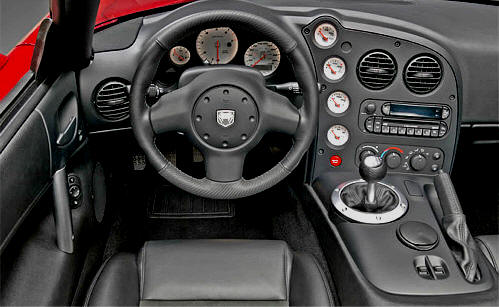

The 2008 Dodge Viper SRT10 will be hand-built
at the Conner Avenue Assembly Plant in Detroit.
2008-2010 Dodge Viper SRT10 Safety and Security
The following safety and security
technologies are featured on the 2008 Dodge Viper SRT10:
- Adjustable Pedals
- Advanced Multistage Front Air Bags with
Occupant Classification System (OCS): Inflates with a force appropriate
to the severity of the impact. The OCS measures the conditions for
activation or deactivation of the passenger side front air bag based
upon the weight of the occupant
- Anti-lock Brake System (ABS)
- BeltAlert: Periodically activates a
chime and illuminates an icon in the instrument cluster to remind the
driver and front passenger to buckle up if a vehicle is driven without
the driver being properly belted
- Center High-mounted Stop Lamp (CHMSL):
The shelf-mounted center high mounted stop lamp uses light emitting
diodes (LEDs) for longer life Constant Force Retractors (CFR):
Distribute force or load exerted on a seat belt, and then gradually
release the seat belt webbing in a controlled manner
- Crumple Zones: Designed to compress
during an accident to absorb energy, decreasing transfer of that energy
to the occupants
- Energy-absorbing Steering Column: The
manual-adjust steering column uses two hydroformed coaxial tubes that
can move relative to each other to allow the column to move forward for
enhanced energy absorption during a crash. The power-adjust steering
column employs a calibrated bending element that deforms during column
stroke for optimal energy management
- Interior Head-impact Protection:
Interior pillars above the beltline and instrument panel – including
areas around windshield and rear window headers, roof and side rail
structures, and shoulder-belt turning loops – specifically designed to
limit head-impact force
- Knee Bolsters: The lower instrument
panel and the glove-box door are designed to properly position the
occupant, enabling the air bags to work effectively
- Remote Keyless Entry (RKE)
- Tire-pressure Monitoring (TPM):
Pressure-sensor modules within the valve stems of all four wheels send
continuous radio-frequency signals to a receiver, and the system informs
occupants when the pressure is too low





Back to
Top of Page - Click Here

2008-2010 Dodge Viper SRT-10
Performance & Standard Features
- 8,380 cc 8.4 liters V 10 front engine with
103.0 mm bore, 100.6 mm stroke, 10.2 compression ratio, overhead valve,
variable valve timing/camshaft and two valves per cylinder EWE
- Premium unleaded fuel 91
- Multi-point injection fuel system
- 16.0 gallon main premium unleaded fuel tank 13.3
- Power: 447 kW , 600 HP SAE @ 6,100 rpm; 560 ft lb , 760 Nm @ 5,000 rpm
2008 Dodge
Viper Handling, Ride & Braking Standard Features
- Four-wheel ABS
- Four disc brakes including four ventilated discs
- Immobilizer
- Rear limited slip differential
- Wishbone front and rear suspension independent with stabilizer bar and
coil springs
2008 Dodge Viper Exterior & Aerodynamics Standard Features
- Body color front and rear bumpers
- Fixed hoop convertible rollover protection
- Manual softtop convertible roof with glass rear window
- Driver and passenger power body color door mirrors
- External dimensions: overall length (inches): 175.6, overall width
(inches): 75.2, overall height (inches): 47.6, wheelbase (inches): 98.8,
front track (inches): 61.6, rear track (inches): 60.9 and curb to curb
turning circle (feet): 40.5
- Front fog lights
- Projector beam lens Bi-Xenon headlights
- Luxury trim alloy & leather on gear knob
- Black paint
- Fixed rear window with defogger
- Tinted glass on cabin
- Weights: curb weight (lbs) 3,440
- Windshield wipers with variable intermittent wipe
2008
Dodge Viper Interior Standard Features
- 12v power outlet:
front and 1
- Air conditioning
- Element antenna
- Peripheral anti-theft protection
- Front ashtray
- RDS audio system with AM/FM, Disc Autochanger and six-disc remote changer
- Cargo capacity: all seats in place (cu ft): 8.4
- Front seats cigar lighter
- Clock
- Full dashboard console, full floor console with covered storage box
- Courtesy lights
- Door ajar warning
- Driver front airbag with multi-stage deployment, passenger front airbag
with occupant sensors and multi-stage deployment
- Sports driver and passenger seat
- 3-point reel front seat belts on driver seat and passenger seat with pre-tensioners
- Front seat center armrest
- Two head restraints on front seats
- Headlight control with time delay switch-off
- Height adjustable pedals
- Illuminated entry system
- Internal dimensions: front headroom (inches): 36.5, front leg room
(inches): 42.4 and front shoulder room (inches): 54.1
- Low tire pressure indicator
- Remote power locks
- Power steering
- Front power windows with two one-touch
- Front reading lights
- Rear view mirror
- Remote control remote trunk/hatch release
- Suede seat upholstery with additional leather
- Seating: two seats
- Seven speaker(s)
- Leather covered steering wheel with tilt adjustment
- Tachometer
- Ventilation system
  



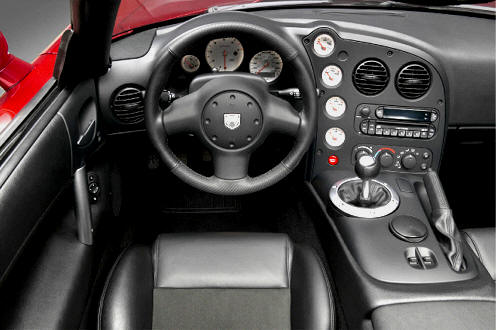
Back to
Top of Page - Click Here

2008 Dodge Viper ACR






2008 VIPER SRT-10
By color scheme:

2009 VIPER SRT-10
Production Break down by color scheme:
2009 Dodge Viper Base Convertible Performance & Efficiency Standard
Features
2009 Dodge Viper Base Convertible Handling, Ride & Braking
Standard Features
-
Four-wheel ABS
-
Four disc brakes including four ventilated discs
-
Immobilizer
-
Rear limited slip differential
-
Wishbone front and rear suspension independent with
stabilizer bar and coil springs
2009 Dodge Viper Base Convertible Exterior & Aerodynamics Standard
Features
-
Body color front and rear bumpers
-
Fixed hoop convertible rollover protection
-
Manual softtop convertible roof with glass rear window
-
Driver and passenger power body color door mirrors
-
External dimensions: overall length (inches): 175.6, overall
width (inches): 75.2, overall height (inches): 47.6,
wheelbase (inches): 98.8, front track (inches): 61.6, rear
track (inches): 60.9 and curb to curb turning circle (feet):
40.5
-
Front fog lights
-
Projector beam lens Bi-Xenon headlights
-
Luxury trim alloy & leather on gearknob
-
Black paint
-
Fixed rear window with defogger
-
Tinted glass on cabin
-
Weights: curb weight (lbs) 3,440
-
Windshield wipers with variable intermittent wipe
2009 Dodge Viper Base Convertible Interior Standard Features
-
12v power outlet: front and 1
-
Air conditioning
-
Element antenna
-
Peripheral anti-theft protection
-
Front ashtray
-
RDS audio system with AM/FM, Disc Autochanger and six-disc
remote changer
-
Cargo capacity: all seats in place (cu ft): 8.4
-
Front seats cigar lighter
-
Clock
-
Full dashboard console, full floor console with covered
storage box
-
Courtesy lights
-
Door ajar warning
-
Driver front airbag with multi-stage deployment, passenger
front airbag with occupant sensors and multi-stage
deployment
-
Sports driver and passenger seat
-
3-point reel front seat belts on driver seat and passenger
seat with pre-tensioners
-
Front seat center armrest
-
Two head restraints on front seats
-
Headlight control with time delay switch-off
-
Height adjustable pedals
-
Illuminated entry system
-
Internal dimensions: front headroom (inches): 36.5, front
leg room (inches): 42.4 and front shoulder room (inches):
54.1
-
Low tire pressure indicator
-
Remote power locks
-
Power steering
-
Front power windows with two one-touch
-
Front reading lights
-
Rear view mirror
-
Remote control remote trunk/hatch release
-
Suede seat upholstery with additional leather
-
Seating: two seats
-
Seven speaker(s)
-
Leather covered steering wheel with tilt adjustment
-
Tachometer
-
Ventilation system
Read more:
http://www.motortrend.com/cars/2009/dodge/viper/specifications/index.html#ixzz0npOrLySG




Only 500 to be built including
Just the Facts:
- Only 50 Final
Edition Dodge Vipers will be built.
- That figure
includes 20 coupes, 18 roadsters and 12 ACRs.
- All will be
painted gray with a black center stripe outlined
in red.
2010 VIPER SRT-10 Color scheme:
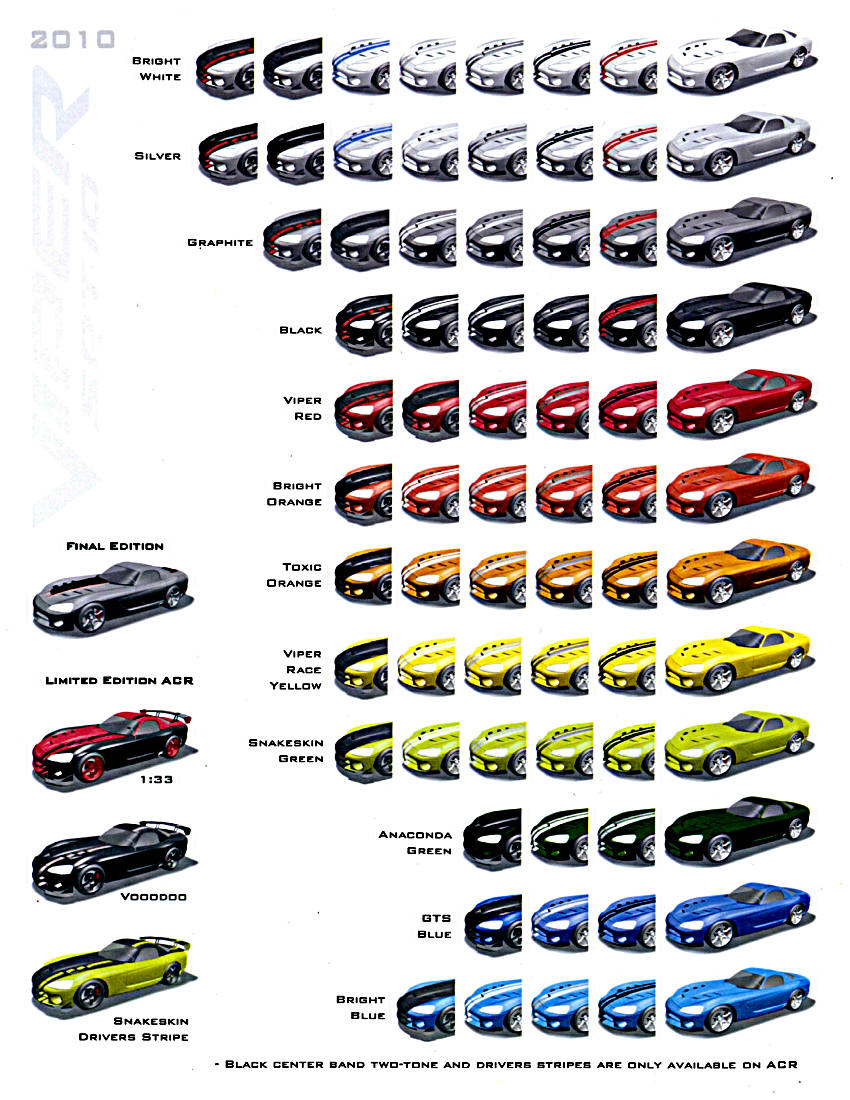
2010 Viper ACR Color Scheme

AUBURN
HILLS, Michigan —
Dodge took the wraps off its 2010 Viper SRT10 Final
Edition models on Tuesday. The company said it will
build 20 coupes, 18 roadsters and 12 ACRs when the
Final Edition models debut in early summer.
True to their name,
the Final Edition models celebrate the Viper's final
year of production. Output will be significantly
less than the 2002 Viper Final Edition coupes and
ACRs, which totaled 360 units, the automaker said.
Pricing has not yet been announced.
Each model gets a
Graphite Clear Coat body with a painted black center
stripe outlined in red. Coupe and roadster models
get six-spoke wheels painted in anthracite, while
ACR models will come with five-spoke, black
"Sidewinder" wheels.
The black interior
has custom red accent stitching, red painted halo
surrounds on the gauge cluster and bright
stainless-steel screws in the center stack bezel.
You'll find an individually numbered plaque on the
shifter bezel. The Final Edition models are
equipped with the usual 600-horsepower 8.4-liter V10
engine.
2008 -
2010 Dodge Viper cars: up to 600
horsepower
For 2008, the Dodge Viper SRT used an
8.4-liter aluminum V-10 engine that
produces a full 600
horsepower
and 560 lb.-ft. of torque. 0-60 times
were reported at being under four
seconds, 0-100-0 in under 12 seconds,
and braking 60-0 comes in less than 100
feet. See how
Dodge Vipers are built! ...
Dodge Viper ACR
For “extended 2009” models there were
four new exterior colors, will be used:
GTS Blue Clear Coat, Snakeskin Green
Pearl Coat, Viper Race Yellow Clear
Coat, VOI X Edition Silver Clear Coat.
New features included Premium Tan
Interior Package, Nappa leather seats
with perforated centers, black and tan
two-tone trim, and a tan canvas
convertible top (roadster
only).
oh20 reported that the 2008 Viper Coupe
and Convertible both averaged over 200
mph around the Transportation Research
Center’s 7.5 mile oval test track in
Ohio. The
convertible
even averaged 197 mph with the top
down. Coupe and convertible have
similar drag (aerodynamic) numbers,
according to representatives of the SRT
team.
 The
invoice price on the 2009 Viper SRT10
Coupe was $82,989 for the base car,
which had an MSRP of $89,340; Customer
Preferred Package 21B added $12,060 (MSRP
$13,550). The gas guzzler tax adds
$1,751 to the cost but Chrysler charges
owners a rounded-down $1,700. The
destination charge of $930 is the same
for the dealer and the buyer. The
invoice price on the 2009 Viper SRT10
Coupe was $82,989 for the base car,
which had an MSRP of $89,340; Customer
Preferred Package 21B added $12,060 (MSRP
$13,550). The gas guzzler tax adds
$1,751 to the cost but Chrysler charges
owners a rounded-down $1,700. The
destination charge of $930 is the same
for the dealer and the buyer.
SRT powertrain engineers had to increase
performance while complying with new
regulatory requirements. Working with
specialists from McLaren Performance
Technologies and Ricardo, Inc., SRT
engineers began by following the racer’s
basic formula for more power: bigger
displacement, more efficient breathing
and higher engine speed.
The new Dodge Viper SRT10’s deep-skirted
V-10 aluminum engine block was bored out
1 mm, raising the displacement to 8.4
liters from 8.3 liters. With
strengthened bulkheads and improved
water jackets for better cooling, the
block includes pressed-in iron cylinder
liners and cross-bolted main bearing
caps for strength and durability.
Horsepower didn't come only from the
engine, the use of a plastic hood
allowed engineers to increase the
airflow through the hood scoop; openings
along each side are not just for show,
but to circulate air within the engine
compartment, to keep power going with a
warm engine. It also lowered weight and
helped keep the Viper costs down. Other
body panels are also plastic, and
carbon
fiber
is used for some structural parts to
keep weight down.
The
Viper SRT10’s 8.4-liter engine had heads with
Computer Numerically Controlled (CNC)-shaped
combustion chambers, larger valves and Variable
Valve Timing (VVT). VVT electronically adjusts when
the exhaust valves are open and closed according to
engine speed and load, allowing the engine to
“breathe” cleaner and more efficiently.
Platinum-tip spark plugs were fired by
individual plug coils mounted on the
cylinder-head covers. The pistons
themselves had larger-diameter floating
pins with bronze bushings for higher
loads. Forged powder-metal connecting
rods were secured with aircraft-quality
fasteners for increased fatigue
strength.
Engine lubrication was managed by a
larger oil pump and a swinging oil
pickup adapted from Viper competition
engines, to improve oil pressure in
high-rpm and hard-cornering conditions.
Back to Top of Page - Click Here

Dodge officially
unveiled the new 2010 Viper at the L.A.
Auto Show—showing two new exterior
colors—Toxic Orange Pearl Coat and
Bright Silver Metallic Clear Coat—with a
wider dual racing stripe pattern. Also
new for 2010 is a revised fifth gear
ratio—.80:1 instead of .75:1—for all
Vipers, to dramatically improve
high-speed acceleration. A standard
Viper will reach 200 mph 14 seconds
faster with the new gear. The idea came
from SRT’s experiences at the
Nürburgring, when Viper set the
production car lap record. It was
thought that the ACR would be even
quicker with the new gear. Will we see a
new expedition to the famous track in
the near future?
The 2010 ACR and
the ACR-X will have new slotted wing
endplates to go with a revised wing
profile to give more downforce in yaw.
This means the 2010 ACR will be even
quicker in corners, which would have
been a factor at Laguna Seca a week
earlier. ACRs also get a short-throw
shifter and the new fifth gear.
To celebrate the
new lap record at Laguna Seca, Ralph
Gilles announced a Viper special edition
ACR, to be built in the same special red
and black livery as the record car. The
paint scheme is the reverse of the one
that was on the Nürburgring
record-setter. The new edition’s name:
“1:33,” to commemorate the record of the
same number. Thirty-three (33) will be
produced.
Lurking in the
pits at Laguna Seca the previous week,
and featured in the Chrysler booth, was
Ralph Gilles’ black ACR with its new
graphite-color driver stripe enhanced by
red outlines. This menacing color
combination is the hallmark of another
new edition named “Vooodoo,” offered for
this 2010 model year. Dodge will produce
only twenty of these darkly beautiful
monsters.
An improved
gearbox, a better ACR aero configuration
and gearshift, striking new colors, two
exciting new special editions and two
new track racers introduced at PRI—Viper
is poised to have a great year in 2010
with even more goodies rumored to be in
the pipeline as Dodge and SRT finish a
legendary run and gear up for 2013.
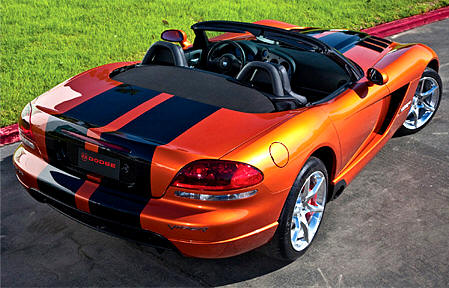
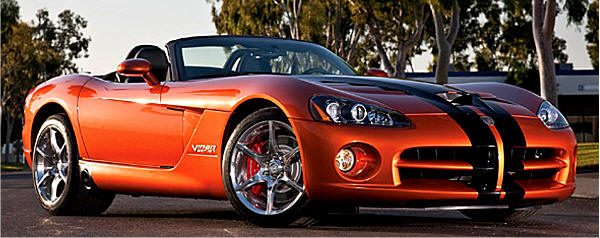

2010 ACR
Numerous special,
limited-edition models are planned for the
2010 model year, including the Vooodoo-edition
Viper ACR will feature an all Black Clear
Coat exterior with a Graphite Driver’s
Stripe outlined in red. Only 20 cars will be
produced with the unique striping on both
the exterior, as well as on the steering
wheel. Additional special edition models will
be announced closer to their individual
introductions. Pricing on the 2010 Dodge
Viper lineup also will be announced at a
later date. Visit your local Dodge Viper
dealer to inquire about this amazing Viper!

Numerous special,
limited-edition models are planned
for the 2010 model year, including
the Dodge Viper ACR 1:33 Edition,
which will pay tribute to the new
production car lap record set on
Nov. 24 at Laguna Seca raceway. The
unique two-tone Black Clear Coat/Red
Clear Coat exterior color scheme on
this model is the opposite form of
the original Viper ACR. Interior
highlights include piano black
console bezels with red gauge
highlights complemented with red
accent stitching in the seats. Only
33 cars will be produced as 1:33
Edition Viper ACR models. Additional
special edition models will be
announced closer to their individual
introductions. Pricing on the 2010
Dodge Viper lineup also will be
announced at a later date. Visit
your local Dodge Viper dealer to
inquire about this amazing Viper!

Viper Club of America
member D’Ann Rauh of Arp, Texas, was the buyer of
the final 2010
Dodge
Viper.
D’Ann worked with Dodge to select personal touches,
including custom bronzed gold exterior paint
supplied by House of Kolor. The custom interior has
leather appointments crafted by Tony Spampinito from
Venzano, who has worked with D’Ann and her husband
on previous Viper projects; they have the largest
personal collection of Vipers in the world, with 40
of the Dodge cars.
Back to
Top of Page - Click Here

|



































 The
invoice price on the 2009 Viper SRT10
Coupe was $82,989 for the base car,
which had an MSRP of $89,340; Customer
Preferred Package 21B added $12,060 (MSRP
$13,550). The gas guzzler tax adds
$1,751 to the cost but Chrysler charges
owners a rounded-down $1,700. The
destination charge of $930 is the same
for the dealer and the buyer.
The
invoice price on the 2009 Viper SRT10
Coupe was $82,989 for the base car,
which had an MSRP of $89,340; Customer
Preferred Package 21B added $12,060 (MSRP
$13,550). The gas guzzler tax adds
$1,751 to the cost but Chrysler charges
owners a rounded-down $1,700. The
destination charge of $930 is the same
for the dealer and the buyer.



